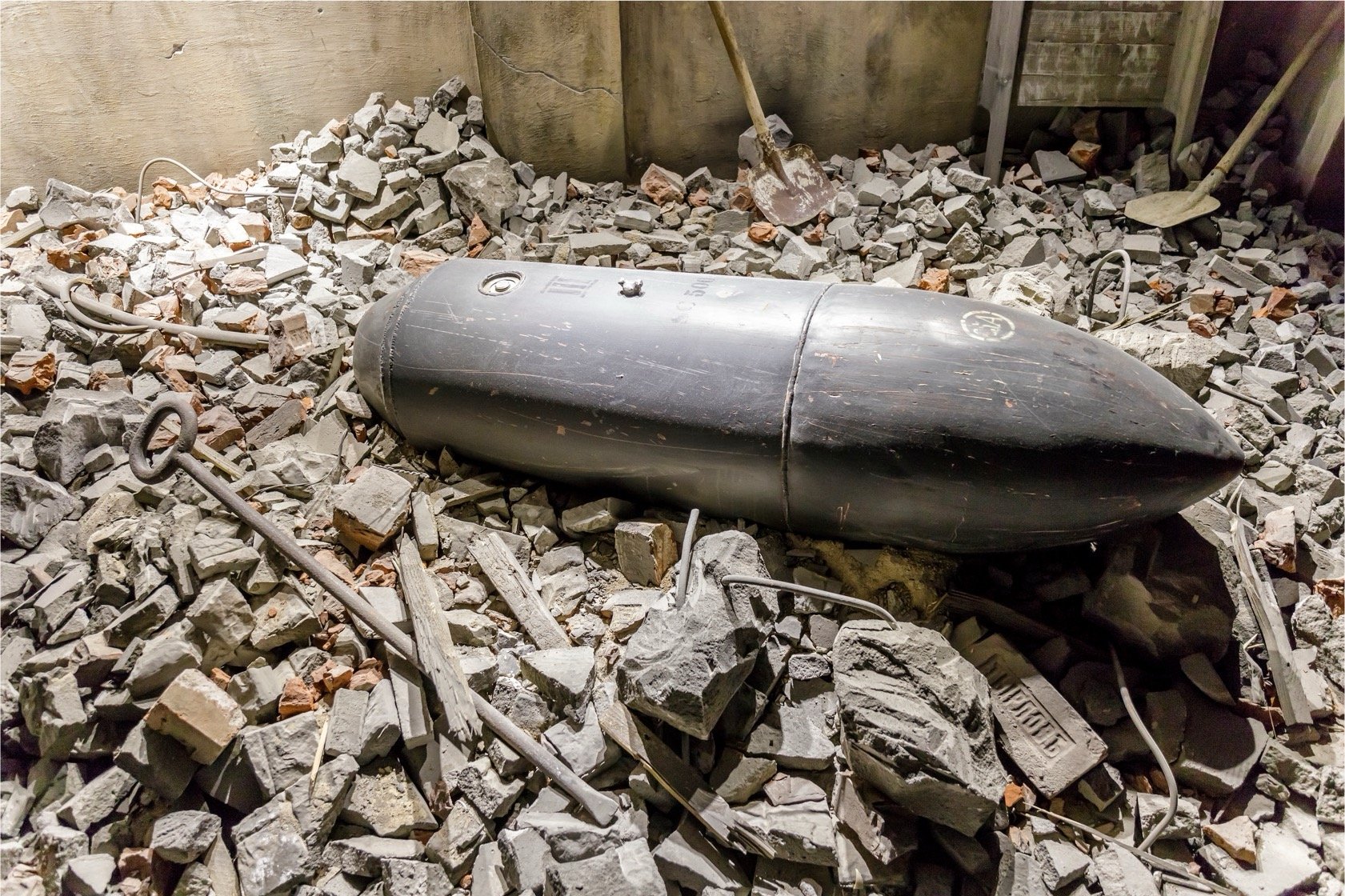
UXO RISK ASSESSMENT
artios specialise in impartial UXO RISK AsSEssMENTS and bomb risk maps.
Artios provides Stages 1-3 of the CIRIA C681 processes through Preliminary Risk Assessments (PRA) , Detailed Risk Assessments (DRAs) and Risk Mitigation Plans. This enables risk management decisions that are informed by assessments that are expressly impartial and unbiased, as we do not provide on-site mitigations at Stage 4.
Stage 1
PRELIMINARY RISK ASSESSMENTS
Despite the intensity of the German 'Blitzkrieg' over the UK during WW2, many parts of the country experienced minimal or no bombing.
A Preliminary Risk Assessment (PRA) based on systematic research and existing data sets can effectively rule out the need for further action at many sites, eliminating the need for further investigations or actions to mitigate potential risks from UXO contamination. Artios PRAs align with Stage 1 for Risk Management Strategy as outlined in the industry-standard 'CIRIA C681 UXO - A Guide for the Construction Industry.'
This initial step follows a cost-effective approach, recognising that, for the majority of UK sites, a quick and straightforward assessment can determine that no further actions are required.
How is your PRA developed, and what information does it contain?
Artios creates Preliminary UXO Risk Assessments using data obtained from thorough desktop research. Following the guidelines of CIRIA C681, our PRA considers four primary factors to assess the risk of potential UXO encounters at a site:
1. The extent and type of wartime bombing in the area.
2. The historical military use of the area, including training, defense, or other purposes, along with the likely types of ordnance used.
3. Post-war development in the area after exposure to potential UXO contamination.
4. The specifications of planned construction work and the exposure of other potential receptors to UXO contamination.
Our PRAs are communicated to you through clear and concise electronic reports, summarising the information and findings.
Stage 2
DETAILED RISK ASSESSMENTS
A higher-risk area identified by a Preliminary Risk Assessment (PRA) undergoes systematic and comprehensive research, leading to a Detailed Risk Assessment (DRA).
This assessment is structured according to Stages 2 and 3 of the Risk Management Strategy outlined in the industry-standard 'CIRIA C681 UXO - A Guide for the Construction Industry.'
Following industry best practices, we recommend a DRA after a Preliminary UXO Risk Assessment has determined the need for a more detailed examination, ensuring the management of risk to a level that is as low as reasonably practicable (ALARP).
How does Artios produce Detailed UXO Risk Assessments?
Artios' Detailed UXO Risk Assessment process relies on information gathered from extensive research across various sources, including:
· Local and national archives.
· Bomb census mapping.
· Luftwaffe and Allied aerial photography.
· Military defensive plans and training records.
· UXO/Bomb incident reports from WWII to the present day.
· Site Walkovers (if required).
Stage 3
RISK MITIGATION PLAN
All our Detailed UXO Risk Assessments contain a transparent and user-friendly UXO Risk mitigation plan for both Health and Safety as well as Business Interruption risks.
This is based on a CIRIA compliance risk rating, that communicates how the application of mitigations will achieve a residual ALARP risk level.
UXO Consultancy Services
Independent Peer Review of Risk Assessments
Effective UXO risk management is both time and cost-intensive and demands reliability. Artios offers an independent peer review service for risk assessments procured for a site.
We provide impartial advice on the appropriateness of recommended mitigations, especially when considering contracting the same provider that conducted the Detailed UXO Risk Assessment for on-site mitigations.
Our independent peer reviews offer assurance and confidence, ensuring that the specified mitigations are genuinely necessary.
UXO Risk Management: Client Representation and Assurance
When on-site UXO mitigations are underway, Artios extends its services to provide external Quality Assurance as your client representative. This ensures that the procured UXO mitigations are executed to the standard specified.
Our external Quality Assurance process commences with a desk-top review of the UXO mitigation company’s systems, procedures, and staff qualifications. Subsequently, on-site visits are conducted to verify that the implementation aligns with industry standards and meets your specific requirements. Additionally, Artios offers advisory support to clients in formulating Statements of Requirement before procuring UXO mitigation services.
This involves carefully defining risk parameters and ensuring optimal Value for Money.

Why use Artios Global for UXO Risk Assessments
Artios Global is your trusted partner for efficient, secure, and expert CIRIA C681 UXO risk management solutions.
-
Impartial Assessments
We provide unbiased risk assessments, ensuring informed decision-making without on-site mitigations.
-
Expert Team
Our highly qualified UXO risk management experts follow industry best practices, boasting decades of experience in explosive ordnance.
-
Proven Research Approach
Utilizing a proven research procedure, we access extensive archives and exclusive internet sources for a comprehensive understanding.
-
Certified Systems
Our Integrated Management System is fully ISO 9001 and 14001 certified, reflecting our commitment to quality and environmental responsibility.
-
Cybersecurity Assurance
Accredited to Cyber Essentials Plus, Artios guarantees the highest level of digital security.
-
Full Indemnification
We are fully indemnified, providing insurance certificates upon request for transparency and accountability.
WHAT TO DO ABOUT UXO RISK ON YOUR SITE?
CIRIA C681 & C785 Stages
UXO Risk Management Guide for Land-Based Projects' are widely recognised and referenced by the UK Construction Industry. CIRIA offers a formal framework for conducting risk assessments, defining parameters to assess UXO risk and outlining risk management in four stages:
Artios specializes in providing Stages 1-3 of the CIRIA C681 processes, involving Preliminary Risk Assessments (PRA), Detailed Risk Assessments (DRAs), and Risk Mitigation Plans. This comprehensive approach allows for informed risk management decisions based on impartial and unbiased assessments. At Stage 4, where on-site mitigations are implemented, we maintain our impartiality by not providing on-site services.
WHY IS UXO CONTAMINATION IN THE UK A PROBLEM?
Understanding the historical context is crucial when considering potential UXO hazards in the UK. It underscores the need for thorough desktop survey risk assessments and appropriate mitigation measures during ground works to ensure the safety of individuals and to minimise business interruption.
-
Sources of UXO Contamination
UXO contamination in the UK presents a potential hazard, particularly during intrusive works. The sources of UXO contamination include:
World Wars: The UK experienced significant UXO contamination during both World Wars. German bombing raids, particularly during World War II targeted numerous cities and regions. Defensive actions, such as anti-aircraft artillery fire and mine laying along beaches and airfields, further contributed to the presence of UXO.
Military Training: Military training activities have been conducted across large portions of the UK and have lead to the persistence of UXO in certain areas.
CONSEQUENCES
Explosive ordnance is generally designed to kill and maim people or destroy infrastructure. This ranges from aerial delivered German munitions dropped during WWII bombing, to items of explosive ordnance such as projectiles, grenades, rockets, and mortars used by military units either in training or in defence. All these items, whether large or small, have the potential to cause catastrophic injuries and damage in the unlikely event an inadvertent initiation (explosion) occurs.
UXO RISK MANAGEMENT
Construction professionals have specific duties under the Construction (Design Management) Regulations 2015 (CDM 2015), under which, the client has the legal responsibility for the way that a construction project is managed and run, and they are accountable for the Health and Safety of those working on, or affected by, a construction project. Other legislation such as Health and Safety at Work Act 1974 and the Management of Health and Safety at Work Regulations 1999, require employers to take measures to protect the health and safety of their employees, and other persons, who would be affected by UXO being encountered during their work.
It is crucial that a comprehensive risk assessment process be applied to determine the measures required to control the risk to an As Low as Reasonably Practicable (ALARP) level.













